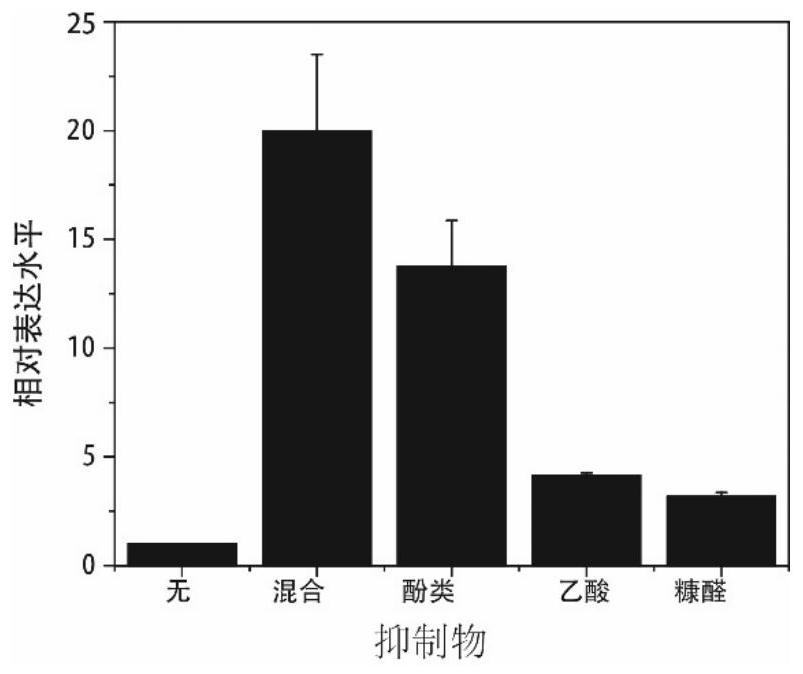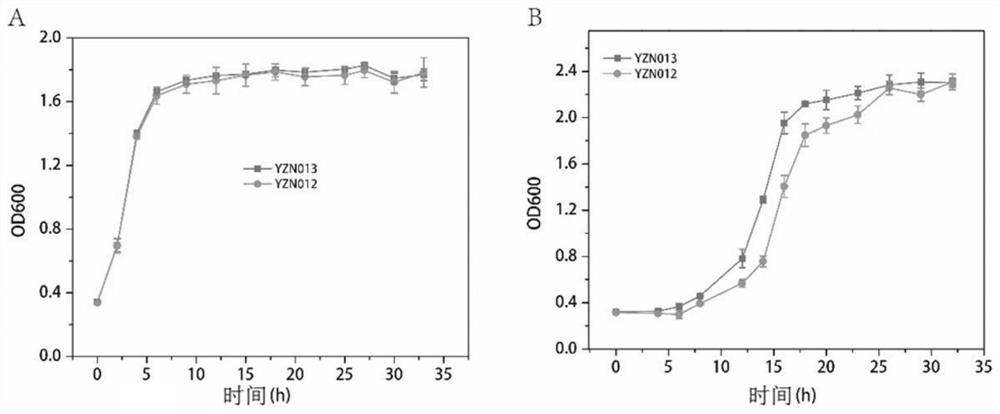Yeast with high tolerance to inhibitors derived from lignocellulosic biomass and construction method thereof
A lignocellulosic and biomass technology, applied in the direction of microorganism-based methods, biochemical equipment and methods, microorganisms, etc., can solve problems such as increasing production costs, increasing saccharification and fermentation production costs, and hindering the commercialization of cellulosic ethanol
- Summary
- Abstract
- Description
- Claims
- Application Information
AI Technical Summary
Problems solved by technology
Method used
Image
Examples
Embodiment 1
[0047] Example 1 Changes in the expression level of the nitroreductase KmHBN1 gene in the presence of different inhibitors.
[0048] First, the inventors measured the changes in the expression level of the nitroreductase KmHBN1 gene in the original strain YHJ010 in the presence of different inhibitors by Real-time PCR. Five groups were set up, namely no inhibitor group, inhibitor mixture group (acetic acid, furfural+5-hydroxymethylfurfural, phenolic mixture (catechol, syringaldehyde, vanillin, 4-hydroxybenzaldehyde )), acetic acid inhibitor group, phenolic mixture inhibitor group (catechol, syringaldehyde, vanillin, 4-hydroxybenzaldehyde), furan mixture inhibitor group (furfural+5-hydroxymethylfurfural) .
[0049] The specific operation is as follows.
[0050] 1. Take out the strain YHJ010 from the -80°C refrigerator, inoculate it into YPD solid medium according to the usual method, and culture it overnight at 37°C.
[0051] 2. On the next day, pick a single clone in YPD li...
Embodiment 2
[0087] The construction of embodiment 2 nitroreductase gene KmHBN1 overexpression bacterial strain:
[0088] 1. Construction of nitroreductase expression vector.
[0089] 1) Cloning of nitroreductase gene. According to the sequence design of the nitroreductase gene (GenBank accession No.: MT383676) in Genbank, primers 10054Up-F (SEQ ID No: 5) and 10054Down-R (SEQ ID No: 6). Using the genomic DNA of the YHJ010 strain as a template, PCR was performed using PrimeSTAR HS DNA polymerase (Dalian Baobio) to obtain a fragment with a length of about 1.7 kb. The fragment was treated with A by the usual method and ligated with pGEM-T Easy (Promega, USA) to form plasmid pZN001. The specific construction process is as follows:
[0090] (1) Extraction of Kluyveromyces marx genome
[0091] a) Take out the preserved yeast strain from the refrigerator at -80°C and inoculate it in YPD solid medium, and culture it overnight in a 37°C incubator.
[0092] b) Pick colonies and inoculate them ...
Embodiment 3
[0145] Example 3 Tolerance test of bacterial strain YZN013 to various inhibitors
[0146] In this example, the inventors tested the tolerance of the nitroreductase gene overexpression mutant strain YZN013 to various inhibitors. The experiment was divided into two groups, the control group (strain YZN012, which does not express nitroreductase, but the auxotrophy is the same as YZN013) and the overexpression group (YZN013).
[0147] 1) Streak the above-mentioned strains YZN012 and YZN013 onto YPD solid medium and cultivate them in a 37°C incubator;
[0148] 2) Pick a single clone into 5mL YPD liquid medium and culture overnight (37°C, 250rpm) to the logarithmic phase;
[0149] 3) Configure synthetic medium (yeast nitrogen base, YNB, Shanghai Sangong) 0.67%, 2% glucose, inhibitor mixture) liquid medium containing inhibitor mixture, and distribute 30mL into Erlenmeyer flasks ;
[0150] Here, the inhibitor mixture is 1.9g / L acetic acid+0.95g / L furan derivative (furfural and 5-hy...
PUM
| Property | Measurement | Unit |
|---|---|---|
| thermal resistance | aaaaa | aaaaa |
Abstract
Description
Claims
Application Information
 Login to view more
Login to view more - R&D Engineer
- R&D Manager
- IP Professional
- Industry Leading Data Capabilities
- Powerful AI technology
- Patent DNA Extraction
Browse by: Latest US Patents, China's latest patents, Technical Efficacy Thesaurus, Application Domain, Technology Topic.
© 2024 PatSnap. All rights reserved.Legal|Privacy policy|Modern Slavery Act Transparency Statement|Sitemap



